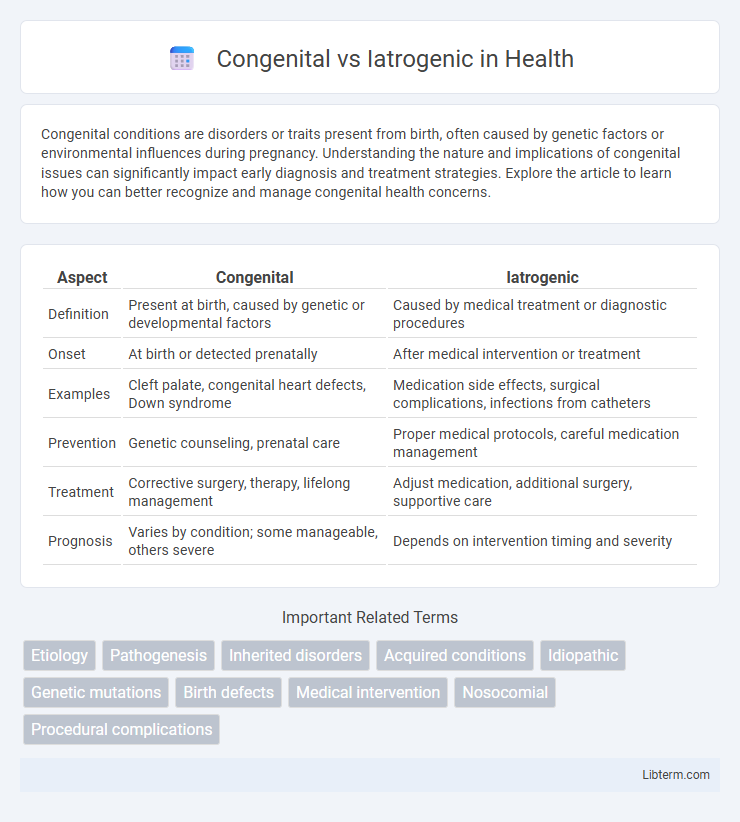Congenital conditions are disorders or traits present from birth, often caused by genetic factors or environmental influences during pregnancy. Understanding the nature and implications of congenital issues can significantly impact early diagnosis and treatment strategies. Explore the article to learn how you can better recognize and manage congenital health concerns.
Table of Comparison
| Aspect | Congenital | Iatrogenic |
|---|---|---|
| Definition | Present at birth, caused by genetic or developmental factors | Caused by medical treatment or diagnostic procedures |
| Onset | At birth or detected prenatally | After medical intervention or treatment |
| Examples | Cleft palate, congenital heart defects, Down syndrome | Medication side effects, surgical complications, infections from catheters |
| Prevention | Genetic counseling, prenatal care | Proper medical protocols, careful medication management |
| Treatment | Corrective surgery, therapy, lifelong management | Adjust medication, additional surgery, supportive care |
| Prognosis | Varies by condition; some manageable, others severe | Depends on intervention timing and severity |
Introduction to Congenital and Iatrogenic Conditions
Congenital conditions are abnormalities present at birth, often caused by genetic factors or environmental influences during fetal development. Iatrogenic conditions arise as unintended consequences of medical treatments, interventions, or diagnostic procedures. Understanding the distinctions between congenital and iatrogenic origins is crucial for accurate diagnosis and tailored patient care.
Definition of Congenital Disorders
Congenital disorders are structural or functional abnormalities present at birth, resulting from genetic, environmental, or unknown factors during fetal development. These conditions include heart defects, neural tube defects, and chromosomal anomalies such as Down syndrome. Congenital disorders contrast with iatrogenic conditions, which are caused by medical intervention or treatment.
Definition of Iatrogenic Disorders
Iatrogenic disorders are adverse conditions or complications directly caused by medical treatment or diagnostic procedures, including medications, surgeries, or radiation. These disorders result from healthcare interventions rather than originating from the patient's underlying diseases or congenital defects. Understanding iatrogenic disorders is essential for improving patient safety and minimizing risks associated with medical care.
Key Differences Between Congenital and Iatrogenic
Congenital conditions originate from genetic abnormalities or events during fetal development, present at birth, whereas iatrogenic conditions result directly from medical interventions or treatments. Congenital disorders often involve inherited mutations or developmental disruptions, while iatrogenic issues arise from surgical errors, medication side effects, or diagnostic procedures. Understanding these distinctions is essential in clinical diagnosis, patient management, and preventive healthcare strategies.
Causes of Congenital Conditions
Congenital conditions primarily arise from genetic mutations, chromosomal abnormalities, or environmental factors affecting fetal development during pregnancy. Teratogens such as infections, drugs, or radiation exposure can disrupt normal embryogenesis, leading to structural or functional anomalies. These causes differ from iatrogenic conditions, which result from medical interventions or treatments after birth.
Causes of Iatrogenic Conditions
Iatrogenic conditions arise from medical interventions such as surgeries, medications, or diagnostic procedures that inadvertently cause harm to the patient. Common causes include adverse drug reactions, surgical errors, or infections acquired during hospital stays. Understanding these causes is crucial for improving patient safety and minimizing preventable medical complications.
Diagnosis and Detection Methods
Congenital conditions are identified primarily through prenatal imaging techniques such as ultrasound and genetic screening, allowing for early detection and diagnosis before or immediately after birth. Iatrogenic conditions are typically diagnosed post-exposure to medical procedures or treatments, using clinical evaluation, patient history, and imaging or laboratory tests to detect complications or adverse effects. Advanced diagnostic tools like MRI, CT scans, and biochemical assays play crucial roles in differentiating congenital abnormalities from iatrogenic causes.
Prevention Strategies for Both Conditions
Congenital conditions require early genetic screening and prenatal care to identify risk factors and prevent complications, while iatrogenic conditions demand strict adherence to medical protocols and continuous training to minimize procedural errors and adverse effects. Implementing comprehensive patient history reviews and employing advanced diagnostic tools enhances prevention by tailoring personalized treatment plans. Emphasizing patient education and multidisciplinary collaboration further reduces the incidence and severity of both congenital and iatrogenic conditions.
Treatment Approaches and Patient Management
Treatment approaches for congenital conditions typically involve early intervention strategies such as surgery, physical therapy, and genetic counseling to address inherent abnormalities. Iatrogenic conditions require targeted management strategies, including cessation of the causative medical agent, supportive care, and sometimes corrective surgery or medication adjustments. Patient management for congenital cases emphasizes lifelong monitoring and multidisciplinary care, whereas iatrogenic cases focus on preventing recurrence and mitigating adverse treatment effects.
Prognosis and Long-term Outcomes
Congenital conditions often present with structural anomalies existing from birth, influencing prognosis based on severity and early detection, with some cases showing stable long-term outcomes if managed promptly. Iatrogenic complications result from medical interventions and may vary widely in prognosis depending on the nature and timing of the injury, often requiring targeted rehabilitation to improve functional recovery. Long-term outcomes in both scenarios depend heavily on the underlying pathology, treatment efficacy, and patient-specific factors such as age and comorbidities.
Congenital Infographic

 libterm.com
libterm.com